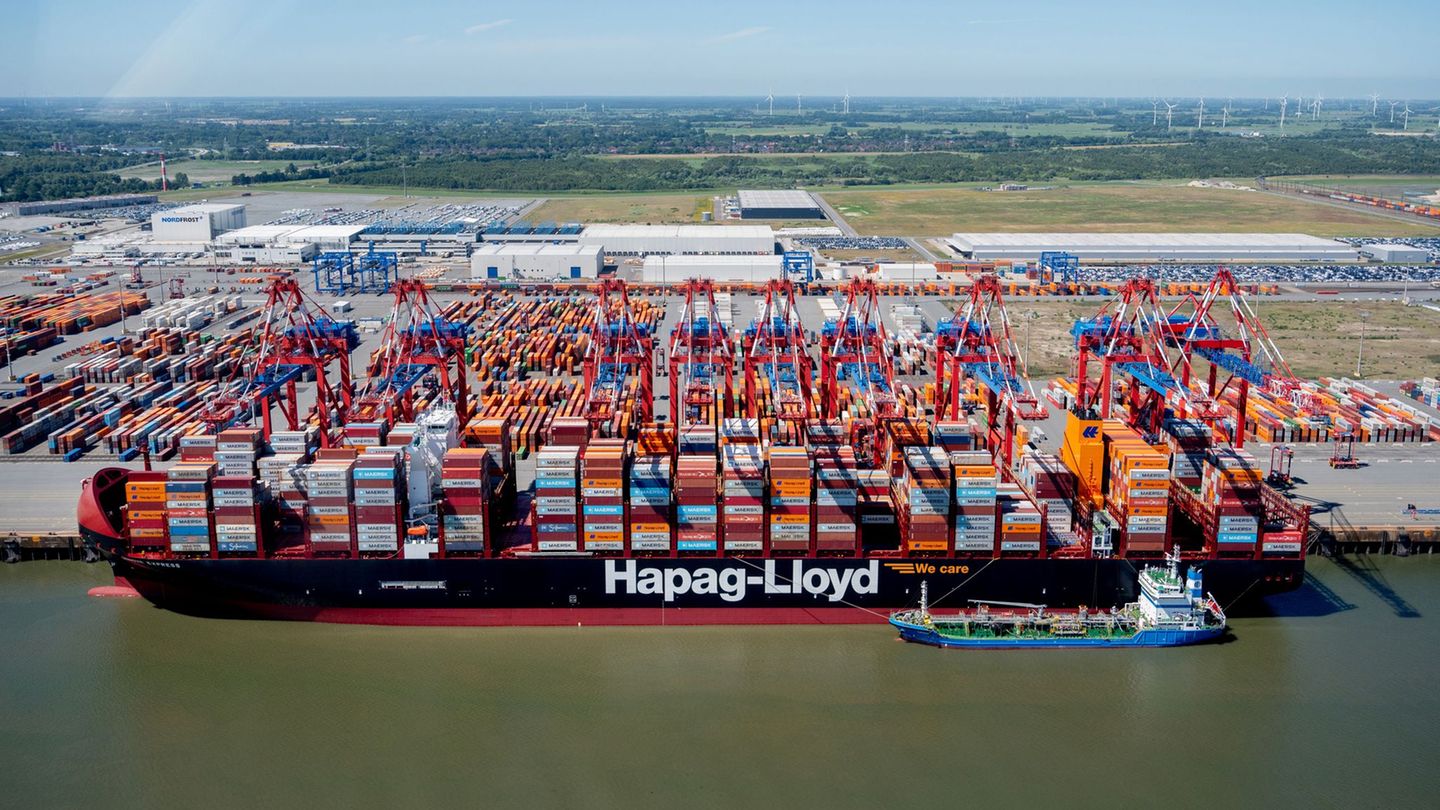“Erratic” US trade policy
Trump’s tariffs spoil German export plus
Copy the current link
Add to the memorial list
There is a slight plus in the balance sheet for the first half of the year. But the German export industry is increasingly under pressure. The customs conflict with the United States threatens to become a permanent burden.
Easy plus for “Made in Germany” in the first half of the year, but cloudy prospects: Germany’s exporters see themselves before difficult times – mainly because of the aggressive customs policy of US President Donald Trump. “The tariffs disadvantage us on the world market and hit the middle class hard in a persistently challenging time,” says the President of the Federal Association of Wholesale, Foreign Trade, Services (BGA), Dirk Jandura. The “erratic trade policy of the United States” is clearly reflected in foreign trade, which increases uncertainty in the trading business.
The situation in industry in Germany remains tense: production sank surprisingly in June, and fewer new orders were received in the month than in the previous month, as can be seen from the latest data from the Federal Statistical Office. The industry “continues to be in a very long valley sole,” according to the analysis of ING chief host Carsten Brzeski.
EU and China make up for weak US business – still
In the meantime, the German exports rose surprisingly strongly despite a shrinking business on the important US market. In total, German production worth 130.5 billion euros were delivered abroad in the month – an increase of 0.8 percent for the previous month and 2.4 percent more than a year earlier, as the Wiesbaden statisticians said. Increasing demand from the European Union and China more than made up for the weakening US business in June.
There was a third decline in the USA business in a row – also because many shops had been preferred in expectation of higher trade barriers. Most German exports went to the United States in June. However, compared to May of the current year, the value of the goods fell by 2.1 percent to 11.8 billion euros. That was the lowest status since February 2022 at then 11.2 billion euros. Compared to June 2024, German exports to the USA even decreased by 8.4 percent.
Light export plus in the half year
Germany’s exporter, which was characterized by the customs dispute with the United States, ended with a slight plus. If “Made in Germany” with a total value of 785.6 billion euros were marketed abroad in the six months. That was 0.6 percent more than from January to June 2024, as can be seen from the latest figures in the Federal Statistical Office.
There were noticeable declines for German manufacturers in the first half of the year in business in the particularly important markets USA (minus 3.1 percent) and China (minus 13.5 percent). US President Trump tries to strengthen the domestic economy with the help of higher tariffs. This increases imports to the United States – a burden for the export -oriented German economy.
Economists warn of a long period of weakness
Commerzbank chief economist Jörg Krämer expects a probably long-term weakness of the US business: “The higher tariffs should drop the price-adjusted exports to the United States by an estimated 20 to 25 percent over the next two years.”
According to Ing economist Brzeski, the German middle class in particular could be victims of the US tariffs, since small and medium-sized companies have more difficulties to shift their production. In addition, the stronger euro exports on the world markets tend to be more expensive. “It seems highly unlikely that exports could soon be an important growth engine for the German economy,” writes Brzeski.
Industrial production at the lowest level since corona pandemic
According to the Federal Statistical Office, the production in the company of the processing trade decreased from May this year by 1.9 percent. Production has thus reached the lowest level since May 2020, when Corona pandemic had caused a slump in production. According to the latest figures from the Federal Office, less was produced in May.
In June, production declines were mainly in mechanical engineering, in the pharmaceutical industry and in the food industry. According to a survey by the Munich IFO Institute, the mood in the chemical industry in this country “deteriorated” significantly. The continued weak industrial economy contains the demand for chemical products – both in Germany and abroad, the ifo explained. Many companies therefore plan a further job cuts.
“No impulses for permanent upswing”
The Federal Ministry of Economics classifies: “The weak development of industrial production in the second quarter should be partly an expression of a counter -movement on the advanced effects in connection with the announced customs increases.” Because of the US tariffs, however, “no impulses for a permanent upswing in the industrial economy are also foreseeable at the beginning of the third quarter,” the ministry said.
Most EU imports in the United States have applied tariffs of 15 percent since Thursday morning. US President Trump had long threatened with a set of 30 percent, the EU Commission then negotiated a reduction in a fundamental agreement. However, the deal is controversial: Critics accuse Commission President Ursula von der Leyen that she had failed to protect the European market in return with equivalent tariffs from importing the US competition.
dpa
Source: Stern




